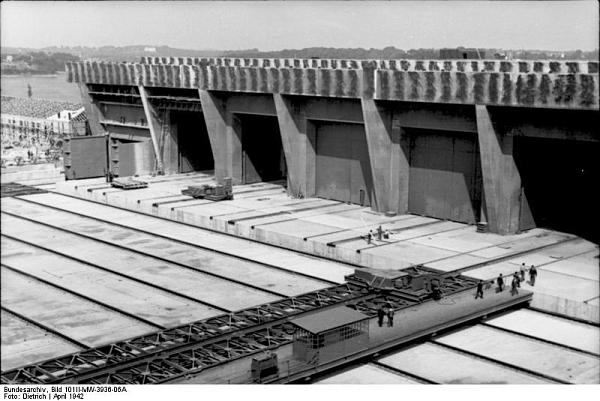

The structure may have only been a couple of metres below ground level but it had 2 metre thick reinforced concrete walls that contained a dormitory area and half a dozen individual rooms for the highest ranking officers. There are numerous display cases of various artefacts from the period along with reconstructed scenes telling stories of the occupation of La Rochelle, the creation of the bunker, and of some of the men who inhabited it. The walls contain posters/information sheets and numerous video screens play newsreel film from the period. Having paid one’s entrance fee and received one of the A4 sized guidebooks available in a relevant language one continues down a flight of fairly steep steps before stepping through a blast door and entering this subterranean world that takes you back some 80 years in time. Built underneath what was then the Hôtel des Étrangers this bunker complex was designed to provide shelter for German U-Boat officers who were billeted in the requisitioned hotel above. They don 't have yet…Ī slight detour away from our walking tour around the town led us to this remarkable piece of WW2 construction. The current generations do not have that immunity and that hatred for everything that is somehow connected with Nazism. However, even in my country there is something similar in Kaliningrad, where a similar museum was created in the bunker of the commandant of Konigsberg- General Otto Lasch. In order for the exposition not to look like an apologetics of the Nazi Kriegsmarine, a small part of the museum is devoted to the French Resistance. An adult (from 12 years old) ticket costs € 9.00. Until 2013, the museum worked by request, now on a permanent basis. Since 1984, a museum has been opened in the bunker. Maybe because both Churchill and Franklin Roosevelt had French Huguenots among their ancestors… After the war, the hotel was demolished from above and a new house was built, but they forgot about the bunker… They remembered it only in the 80s. Although 350 air alerts were issued from June 1940 to August 1944, all 42 Royal Air Force raids fell on La Palisse Base and Laleu Airfield.


2-meter walls and ceilings had to withstand direct hits from British bombs. The subcontractor of Todt's Organization, Hanbuch & Sohn, built a 280 m2 bunker consisting of two large rooms designed for a total of 62 officers, and 6 separate rooms, including two admirals, a large bar, an office, a technical room and toilets. In the event of Allied air raids on La Rochelle, the bunker was supposed to save the lives of Germany's most expensive submarine officers. The museum is located in a real bunker built in 1941 for the Kriegsmarine officers who stayed in the hotel upstairs. The base in La Rochelle has been preserved, but for this you need to go from the center to La Palisse.

Descendant of Huguenots who emigrated to Prussia in the middle of the XVIII century. The irony of the story was that one of the organizers at the first stage was the best submariner of all time, Vice Admiral of the Kriegsmarine Lothar Arnaud de la Perriere. After the occupation of France in 1940, the Nazis created a chain of submarine bases on the coast of the Bay of Biscay in Brest, Lorient, Saint-Nazaire and La Rochelle in order to blockade Great Britain by sea. This attraction is more for boys who are known to love war.


 0 kommentar(er)
0 kommentar(er)
